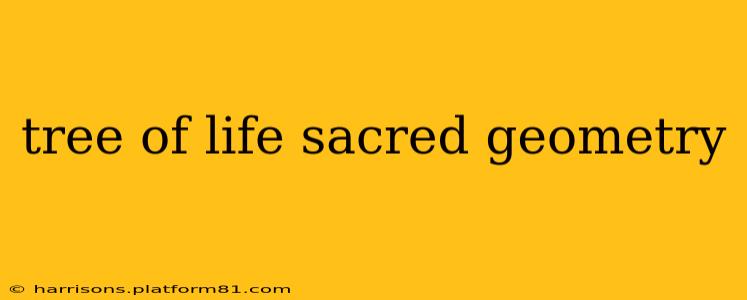The Tree of Life, a powerful symbol found across numerous cultures and spiritual traditions, holds deep significance, particularly within the context of sacred geometry. Its intricate design, often depicted as a branching structure with interconnected nodes, is believed to represent the interconnectedness of all things and the pathways to spiritual enlightenment. This article delves into the fascinating world of the Tree of Life and its relationship to sacred geometry, exploring its symbolism and the mathematical principles underlying its design.
What is the Tree of Life in Sacred Geometry?
In sacred geometry, the Tree of Life isn't simply a drawing; it's a visual representation of fundamental universal principles. It's a complex interplay of circles, lines, and nodes, each element carrying symbolic weight. Different traditions, such as Kabbalah, interpret the Tree of Life differently, assigning specific meanings to its ten Sephirot (nodes) and the twenty-two paths connecting them. However, the underlying principle remains consistent: the interconnectedness of creation and the journey of spiritual evolution. The precise geometric ratios and proportions used in its construction are often debated, but the underlying principles of harmony and balance are consistently emphasized. The Tree of Life serves as a map of consciousness, guiding individuals on their path to self-discovery and union with the divine.
What are the different interpretations of the Tree of Life?
The Tree of Life's symbolism is remarkably versatile, adapting to different cultural and spiritual contexts. In some traditions, it represents the cosmic tree connecting the heavens and the earth, acting as a conduit for energy and wisdom. Others view it as a family tree, tracing lineages and ancestral connections. Still others interpret it as a roadmap of the soul's journey, with each Sephirah representing a stage of spiritual growth. This adaptability speaks to the symbol's inherent power and its resonance across diverse belief systems. The interpretation often depends heavily on the specific tradition and its associated symbolism.
What are the symbols and meanings of the Tree of Life?
The ten Sephirot, the nodes of the Tree of Life, are often associated with specific attributes and archetypes. These vary depending on the tradition, but common themes include wisdom, understanding, mercy, justice, and strength. The paths connecting the Sephirot represent the dynamic interplay between these attributes, highlighting the interconnectedness of seemingly disparate aspects of existence. The overall design often incorporates geometric shapes like circles and triangles, reinforcing the connection between the Tree of Life and the principles of sacred geometry. The visual representation frequently involves a carefully arranged composition, symbolizing a holistic interconnectedness and a balanced system.
How is the Tree of Life related to Kabbalah?
In Kabbalah, the Tree of Life is central to its mystical understanding of the universe. It provides a framework for understanding God's creation and the process of spiritual evolution. Each Sephirah is understood as an emanation of the divine, representing different aspects of God's attributes and their manifestation in the world. The paths connecting them represent the relationships between these emanations and the processes by which they interact. The study of the Kabbalistic Tree of Life is a complex and profound undertaking, requiring dedicated study and contemplation.
How can I use the Tree of Life for meditation?
The Tree of Life's intricate design lends itself beautifully to meditative practices. Visualizing the Tree of Life, focusing on its interconnectedness, and contemplating the meaning of each Sephirah can be a powerful tool for self-reflection and spiritual growth. Guided meditations often utilize the Tree of Life as a framework for exploring different aspects of the self and connecting with the divine. Many find focusing on the geometric patterns and their inherent harmony to be calming and centering. This practice encourages a deeper understanding of one's connection to the universe and promotes inner peace.
What are some common misconceptions about the Tree of Life?
One common misconception is that the Tree of Life has one singular, universally accepted interpretation. While core principles remain consistent, the specific meanings and interpretations vary significantly across different traditions and schools of thought. Another misconception is that understanding the Tree of Life is solely an intellectual exercise. While intellectual understanding is valuable, the true power of the Tree of Life lies in its application to personal spiritual growth and contemplation. It's a tool for inner transformation, not just academic study.
The Tree of Life, with its roots in sacred geometry, continues to captivate and inspire. Its enduring appeal lies in its ability to transcend cultural boundaries and offer a powerful visual representation of the fundamental principles of interconnectedness and spiritual growth. Whether viewed through a Kabbalistic lens, a pagan perspective, or a purely artistic appreciation, the Tree of Life remains a potent symbol of the universe's intricate design and the human journey towards enlightenment.
